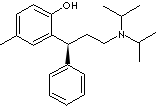|
TOLTERODINE TARTRATE |
| (+)-(R)-2-(I-(2-(Diisopropylamino)ethyl)benzyl)-p-cresol L-tartrate; Detrusitol; Detrol; (R)-2-(3-(Bis(1-methylethyl)amino)-1-phenylpropyl)-4-methylphenol (R-(R',R'))-2,3-dihydroxy butanedioate; |
|
|
| PRODUCT IDENTIFICATION |
|
|
CAS RN |
124937-51-5 (parent), 124937-52-6 (tartrate) |
|
EINECS RN |
|
|
FORMULA |
C26H37NO7 |
|
MOLE WEIGHT |
475.57 |
|
|
| PHYSICAL AND CHEMICAL PROPERTIES |
|
|
PHYSICAL STATE |
White crystalline powder |
|
MELTING POINT |
206 - 207 C |
|
BOILING POINT |
|
|
DENSITY |
|
|
SOLUBILITY IN WATER |
(Soluble in methanol, slightly sol in ethanol, insoluble in toluene) |
|
pH |
|
|
VAPOR DENSITY |
|
|
REFRACTIVE INDEX |
|
|
FLASH POINT |
|
|
|
| STABILITY AND REACTIVITY | |
| STABILITY | Stable under normal conditions. |
|
INCOMPATIBLE MATERIALS |
Strong oxidizing agents. |
| DECOMPOSITION PRODUCTS | carbon oxides |
| POLYMERIZATION | Has not been reported |
|
NFPA RATINGS |
|
|
|
| SAFETY |
|
|
HAZARD NOTES |
|
|
EYE |
|
|
SKIN |
|
|
INGESTION |
|
|
INHALATION |
|
|
CHRONIC |
|
|
|
| TRANSPORT & REGULATORY INFORMATION |
|
|
UN NO. |
|
| HAZARD CLASS |
|
| PACKING GROUP |
|
| HAZARD SYMBOL |
|
|
RISK PHRASES |
|
|
SAFETY PHRASES |
|
|
|
| OTHER INFORMATION |
||||||||||||||||||||||||||||||||||||||||||||||||||||||||||||||||||||||||||||||||||||||||||||||||||||
|
Tolterodine is used to treat the symptoms of an overactive bladder. These are:
urinary frequency (a need to pass water often), urinary urgency (a need to pass
water urgently) and urinary incontinence (a lack of control over passing water).
Tolterodine works by reducing the muscle contractions that cause these symptoms.
(source:
http://www.patient.co.uk/)
Tolterodine is a competitive muscarinic receptor antagonist. Both urinary bladder contraction and salivation are mediated via cholinergic muscarinic receptors. After oral administration, tolterodine is metabolized in the liver, resulting in the formation of the 5-hydroxymethyl derivative, a major pharmacologically active metabolite. The 5-hydroxymethyl metabolite, which exhibits an antimuscarinic activity similar to that of tolterodine, contributes significantly to the therapeutic effect. Both tolterodine and the 5-hydroxymethyl metabolite exhibit a high specificity for muscarinic receptors, since both show negligible activity or affinity for other neurotransmitter receptors and other potential cellular targets, such as calcium channels. Tolterodine has a pronounced effect on bladder function. The main effects of tolterodine are an increase in residual urine, reflecting an incomplete emptying of the bladder, and a decrease in detrusor pressure, consistent with an antimuscarinic action on the lower urinary tract. For the treatment of overactive bladder (with symptoms of urinary frequency, urgency, or urge incontinence) (source: http://www.mongabay.com) Muscarinic antagonists
|
|
|
| SALES SPECIFICATION |
|
|
APPEARANCE |
White crystalline powder |
|
ASSAY |
98.0% max |
|
ACIDITY |
3 - 4 |
|
OPTICAL ROTATION |
+30° ~ +36° |
|
HEAVY METALS |
20ppm max |
|
LOS ON DRYING |
1.0% max |
|
RESIDUE ON IGNITION |
0.1% max |
